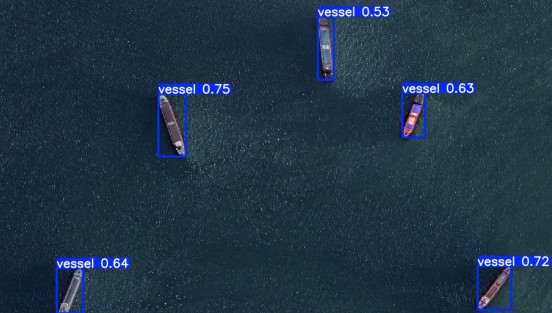Vessel Detection Model
This model performs vessel detection using YOLOv11 architecture. Two versions are available:
- YOLOv11-nano (public)
- YOLOv11-xlarge (private, enterprise)
Model Description
The model is trained to detect vessels in maritime imagery. It uses the YOLOv11 architecture with improvements in detection accuracy and speed.
Performance
YOLOv11-nano (Public Version)
- mAP50: 0.474
- mAP50-95: 0.192
- Precision: 0.587
- Recall: 0.476
YOLOv11-xlarge (Enterprise Version)
- mAP50: 0.579
- mAP50-95: 0.318
- Precision: 0.612
- Recall: 0.571
For access to the enterprise version, please contact [email protected]
Usage
pip install huggingface_hub ultralytics matplotlib
from huggingface_hub import hf_hub_download
from ultralytics import YOLO
import matplotlib.pyplot as plt
# Download the model file and a sample image from Hugging Face
repo_id = "truthdotphd/vessel-detection"
model_path = hf_hub_download(repo_id=repo_id, filename="model.pt")
image_path = hf_hub_download(repo_id=repo_id, filename="vessels.jpg")
# Load the model
model = YOLO(model_path)
# Use the model for inference
results = model(image_path)
plt.figure(figsize=(10, 10))
plt.imshow(cv2.cvtColor(img, cv2.COLOR_BGR2RGB)) # Convert BGR to RGB for matplotlib
plt.axis('off')
plt.show()
Limitations
- Performance may vary depending on image quality and lighting conditions
- Optimized for daytime maritime imagery
- Detection accuracy may decrease in crowded scenes
Training Data
The model was trained on a proprietary dataset of maritime vessel images. The dataset includes various vessel types under different weather and lighting conditions.
Training Procedure
- Architecture: YOLOv11
- Training Framework: Ultralytics
- Hardware: NVIDIA GPUs
- Optimization: AdamW optimizer
For enterprise solutions and access to YOLOv11-xlarge, please contact [email protected]
- Downloads last month
- 7
Inference Providers
NEW
This model isn't deployed by any Inference Provider.
🙋
Ask for provider support
HF Inference deployability: The model has no library tag.
Model tree for truthdotphd/vessel-detection
Base model
Ultralytics/YOLO11